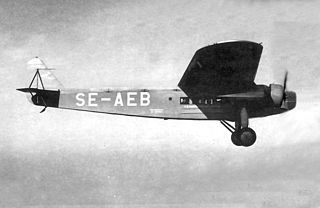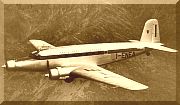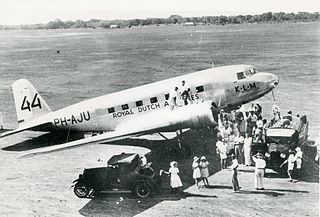
KLM Royal Dutch Airlines, legally Koninklijke Luchtvaart Maatschappij N.V., is the flag carrier of the Netherlands. KLM is headquartered in Amstelveen, with its hub at nearby Amsterdam Airport Schiphol. It is a subsidiary of the Air France–KLM group and a member of the SkyTeam airline alliance. Founded in 1919, KLM is the oldest operating airline in the world, and has 35,488 employees with a fleet of 110 as of 2021. KLM operates scheduled passenger and cargo services to 145 destinations.

An emergency exit in a building or other structure is a special exit used during emergencies such as fires. The combined use of regular and emergency exits allows for faster evacuation, and emergency exits provide alternative means of evacuation if regular exits are inaccessible.

Johan Adolf Pengel International Airport, also known as Paramaribo-Zanderij International Airport, and locally referred to simply as JAP, is an airport located in the town of Zanderij and hub for airline carrier Surinam Airways, 45 kilometres (28 mi) south of Paramaribo. It is the larger of Suriname's two international airports, the other being Zorg en Hoop with scheduled flights to Guyana, and is operated by Airport Management, Ltd./ NV Luchthavenbeheer.

A pre-flight safety briefing is a detailed explanation given before take-off to airline passengers about the safety features of the aircraft they are aboard.

The Fokker F.IX was an airliner developed in the Netherlands in the late 1920s, intended to provide KLM with an aircraft suitable for regular services to the Dutch East Indies. When the onset of the Great Depression forced the postponement of those plans, the market for this aircraft disappeared as well, although it did see military service in Czechoslovakia as a bomber.
Det Danske Luftfartselskab A/S or DDL, trading in English as Danish Air Lines, was Denmark's national airline from 1918 until it merged to create Scandinavian Airlines System (SAS) in 1951. DDL was established on 29 October 1918, but started its first scheduled route on 7 August 1920.

The Fokker F.III was a single-engined high-winged monoplane aircraft produced in the 1920s by the Dutch aircraft manufacturer Fokker. It could carry five passengers. The aircraft was also built under licence in Germany as the Fokker-Grulich F.III.

The 1927 KLM Fokker F.VIII crash happened on 22 August 1927 when Fokker F.VIII H-NADU of KLM crashed at Underriver, Kent, following structural failure of the tailfin or rudder. The aircraft was operating an international scheduled flight from Croydon, Surrey, to Waalhaven Airport, Rotterdam, the Netherlands. One of the two crew was killed and eight people were injured.

Pakistan International Airlines Flight 631 was a domestic scheduled passenger flight on 8 December 1972 operated by the Pakistan International Airlines that took off from Gilgit Airport in Gilgit, Pakistan, bound for Rawalpindi International Airport in Rawalpindi. The involved aircraft was a Fokker F-27. The aircraft crashed in mountainous terrain killing all people on board.

Gerrit Johannes "Geys" Geysendorffer was a Dutch aviation pioneer, knight in the Order of Orange-Nassau, and recipient of the 1926 Harmon National Trophy for the Netherlands.

The Transports Aériens Intercontinentaux Douglas DC-6B scheduled flight from Saigon, Vietnam to Paris, France crashed on 20 February 1956 before its third stopover 25 km North-East of Cairo International Airport due to crew error and possible fatigue. 52 people on board were killed.

On 1 July 1948 the Avio Linee Italiane Fiat G.212PW “I-ELSA” was an international scheduled passenger flight from Milano-Linate Airport, Italy to Brussel-Zaventem Airport, Belgium. The airplane crashed during an emergency landing at 12:20pm local time. Eight of the twelve people on board were killed.

On 14 July 1935 Fokker F.XXII PH-AJQ Kwikstaart was an international passenger flight from Amsterdam via Hamburg and Copenhagen to Malmö. The plane crashed and burned down shortly after take-off just outside Schiphol after both left side engines failed due to a defect in the fuel system, killing four crew members and two passengers. Fourteen people survived.

On 20 July 1935 a Douglas DC-2 aircraft, registration PH-AKG, operated by KLM, flying from Milano, Italy to Schiphol, Amsterdam, in the Netherlands crashed at Pian San Giacomo, Switzerland, killing all thirteen people on board, in the deadliest KLM accident at that time. It was the company's third international passenger flight accident in one week, which became known as the "black week". This left KLM short of crew and airplanes, and routes were given up; the Amsterdam—Milan route was taken over by Deutsche Lufthansa.

On 24 April 1924, KLM Royal Dutch Airlines (KLM) operated the Fokker F.III H-NABS on an international passenger flight from Croydon Airport in the United Kingdom to Waalhaven, the Netherlands. The plane, its pilot, and the two passengers on board disappeared while flying over the English Channel. Despite a large search operation, the plane was not found, and is presumed to have crashed into the Channel.

On 19 December 1934 the KLM Royal Dutch Airlines operated Douglas DC-2-115A Uiver was an extra scheduled international Christmas mail-and-passenger flight from Schiphol Airport in Amsterdam, the Netherlands, to Batavia in the Netherlands East Indies with eight intermediate stops.

On 16 July 1935 a Douglas DC-2 aircraft, registration PH-AKM, operated by KLM, flying from Batavia, Dutch East Indies with several stopovers to Schiphol, Amsterdam, the Netherlands. After an emergency landing in Bushire, Iran the plane crashed the next day during take-off and the plane burned down.

On 25 June 1925, KLM-owned Fokker F.III H-NABM was a passenger flight from Schiphol Airport, the Netherlands to Paris, France. Due to bad weather it struck trees in the Forêt de Mormal and crashed. The pilot and all three passengers were killed.

















